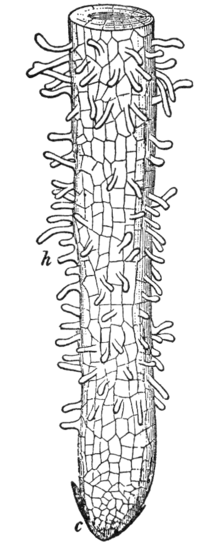Root hair

A root hair, or absorbent hair, the rhizoid of a vascular plant, is a tubular outgrowth of a trichoblast, a hair-forming cell on the epidermis of a plant root. As they are lateral extensions of a single cell and only rarely branched, they are invisible to the naked eye. They are found only in the region of maturation of the root. Just prior to the root hair cell development, there is a point of elevated phosphorylase activity.
Function
The function of root hairs is to collect water and mineral nutrients present in the soil and take this solution up through the roots to the rest of the plant. As root hair cells do not carry out photosynthesis they do not contain chloroplasts.
Formation
Root hair cells are outgrowths at a tip of the plant's roots. Root hair cells vary between 15 and 17 micrometres in diameter, and 80 to 1,500 micrometres in length.[1] They are found only in the zone of maturation, and not the zone of elongation, possibly because any root hairs that arise are sheared off as the root elongates and moves through the soil.
Importance
Root hairs form an important surface over which plants absorb most of their water and nutrients. They are also directly involved in the formation of root nodules in legumeplants.
They have a large surface area, which makes absorbing water during osmosis and minerals during active uptake more efficient. Also, root hair cells secrete acid (H+ from malic acid) which exchanges and helps solubilize the minerals into ionic form, making the ions easier to take up.
Survival
Root hair cells can survive for 2 to 3 weeks and then die off, at the same time new root hair cells are continually being formed at the tip of the root. This way, the root hair coverage stays the same. When a new root hair cell grows, it excretes a poison so that the other cells in close proximity to it are unable to grow one of these hairs. This ensures equal and efficient distribution of the actual hairs on these cells.
The act of re-potting or transplanting a plant can result in root hair cells being pulled off, perhaps to a significant extent, and such plants may therefore wilt for some time as a result.
See also
References
- ^ Dittmar, cited in Esau, 1965
Further reading
- Esau, K. 1965. Plant Anatomy, 2nd Edition. John Wiley & Sons. 767 pp.
